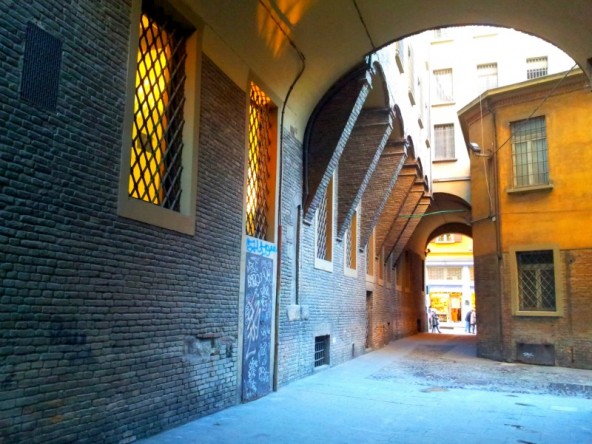 It took approximately 11 years following the issuance of the Papal Bull Cum nimis absurdum for all Bolognese Jews to enter into the “Jewish cage”.
It took approximately 11 years following the issuance of the Papal Bull Cum nimis absurdum for all Bolognese Jews to enter into the “Jewish cage”.
The creation of the ghetto was controversial and met with the usual level of resistance, especially on the part of the Jews. In the end, the ghetto was created out of the part of town where most Jewish families already lived.
Many other families, however, were forced to relocate. Documents show that the Da Rieti brothers were forced to sell the building in which they lived, which was located on the corner between Piazza San Simone and Via Oberdan. Many Christians, on the other hand, while reluctant to abandon what was the “most valuable hub of the city”, were forced to give up their homes and “their stables” to rent them to Jews (who were not allowed to own property). This is confirmed by a document held in the collections of the Archivio di Stato in Bologna.
The ghetto included two large arteries: Strada San Donato (today’s Via Zamboni) and Via Cavaliera (today’s Via Oberdan), which provided four large doors that served as access points (although probably only three of them were used).
The first door was at the beginning of Via dei Giudei (“from San Marco to Porta Ravegnana"): the second, at the point in which Via del Carro leads into Strada San Donato (Via Zamboni), “at the Manzoli’s home", and a third, in what is currently Piazzetta San Simone that opens onto Via Cavaliera (Via Oberdan), “at the Bevilacqua’s home”. Today one can still walk these streets and get a sense of the area that made up the ghetto, but the only access point that is still visible is the second one: a door under the large vaulted roof built in the early 1700s, which connects the Manzoli-Malvasia building with the little church of San Donato.
The entire perimeter of the ghetto, which makes up the medieval heart of the city, still maintains its original structure and in recent times has been the subject of conservation and improvement plans.
We start on Via dei Giudei, whose name derives from the presence of Jewish families here even before the creation of the ghetto. During the Fascist period the name changed to Via delle due Torri.
The first large door giving access to the ghetto was at the entrance of this street. Continuing on Via dei Giudei, in the direction of Via Canonica, we encounter a small gallery and print shop on the right that specializes in Jewish iconography. Turning right from Via Canonica brings us to Via dell ‘Inferno, which was perhaps the central artery of the ghetto. The building at no. I6 (in ancient times, no. 2638) probably contained the only synagogue allowed by the papal authorities, located, according to local accounts, in the “Buratti homestead”, a fact that has not yet been confirmed by the available documentation.
The synagogue was on the top floor of the building, and had a completely anonymous facade (which is still the case). The building is a single unified structure that includes no. 16, Via dell’lnferno and no. 5, Vicolo Mandria.
The inside of the building opens up into a series of courtyards, from street nos. 2 to 16, that correspond, as Lucio Pardo theorizes in his research on the Bolognese ghetto, with the characteristics of a synagogue’s chatzer: an internal area for meetings, common to all the homes and accessible without requiring the inhabitants to exit to the street. The creation of internal passageways between houses was a common practice in all of the ghettos in the Italian peninsula, a practice that was dictated by the need for security.
The next building in the direction of Via Valdonica displays a memorial tablet that commemorates the creation of the ghetto and the persecution of Bolognese Jews, which resulted in their being “isolated in their ghetto.” In the front. under the portico, one can still see a small peephole that was used to keep watch over the street during the period of the ghetto. From Via Valdonica, we pass through an arch and arrive at Via del Carro, where the third large door to the ghetto was located at the entrance to the street and Via Zamboni. Continuing down Via del Carro we end up back on Via dell ‘Inferno.
Turning right, past Vicolo Tubertini, takes us to Vicolo del Mandria, where in Piazzetta San Simone there was another large door that enclosed the ghetto. The ghetto comes alive with theatre and music during the course of the year with cultural initiatives sponsored by the city and the Jewish Museum.
Font: "Jewish tours in Emilia Romagna" - Touring Club Italiano



